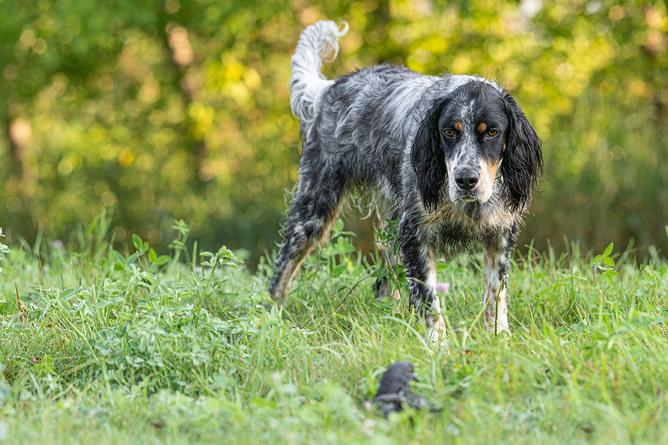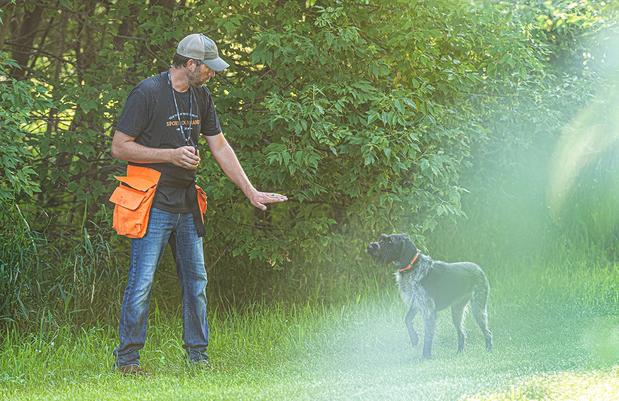
Training Pointing Dogs with Birds - Part 2
Posted by LTC Jim MorehouseIn Part One of this series I explained why “Whoa” is the most important command in pointing dog training. Now I’ll explain the next step I take toward tying “Whoa” and live birds together.
I want to give my young dogs plenty of experience with finding live birds. One, it’s fun. Two, it’s also educational. I want them to learn that they can’t catch a bird. It’s their job to locate it and stand still. But early on I’m not concerned with them holding point.
I mainly use pigeons with my young dogs. They’re usually easier to get than quail, and they cost less. More importantly, pigeons fly better than quail most of the time. That’s important because again, I don’t want a dog to catch a bird. I never use release traps with young dogs because sometimes they can startle them, and that could lead to a dog actually avoiding bird scent.
In a relatively small area with some good cover, I’ll take four or five pigeons, slightly daze them and tuck them into the cover. I always plant these birds fairly close to wherever we’re starting our walk. This is another lesson for the dog to pick up on: You don’t have to run out of the country to find birds. I want my dogs to learn that if they stay near me, they’re always going to find birds.
So, we head out on our walk and eventually a pup finds that pigeon and tries to catch it. The bird flies away and the dog chases it, which is fine. This exercise has nothing to do with control or “Whoa.” This is also the stage at which I introduce the gun. You want to introduce that loud gunfire when the dog’s mind is on chasing the bird. I pop off a .410 shotgun or .22 pistol while the dog is running after the bird. His mind might register the sound, but it’s nothing that startles him. He makes an association between birds and gunfire, which is good. If you do this enough times you’re never going to have a gun shy dog.
Depending on the dog’s age and maturity and if you live in an area that has lots of wild birds, you can also take your young dog hunting. There’s no goal other than that to expose him to more birds. He might stop and point sometimes, and if a bird flushes, go ahead and shoot. If he flushes a bird, then don’t.
Even though we’re out having a good time and finding planted birds and maybe even some wild ones, none of that negates the “Whoa” and tug training I explained in my earlier article. Now it’s time to put your dog back on the check cord and tie everything together.
The first step I take in breaking a dog in the presence of birds is to outfit a very stout fishing pole with a 10-foot cord and a live pigeon in a harness. I’ll have a helper hide behind a bush and then I’ll bring the dog up into the area and the helper will throw that pigeon right in front of the dog, out about 6 or 8 feet. If the dog moves toward the bird, I give him the “Whoa” with a tug. We repeat this over and over until after a while I just give the tug. After enough repetitions of this, I don’t need to do either. Again, I’m trying to get that dog to understand it’s his job to just find the birds, and then that job is done. Eventually we work up to the point where the pigeon can practically be standing on the dog’s nose and he won’t move.
Now you have a dog that understands “Whoa” and knows to do so around birds. In Part Three of this series, I’ll explain how to continue these types of exercises using more live birds.

LTC Jim Morehouse
Tuscon, AZ
Raised in the Finger Lakes area of New York State, Jim was involved in hunting and birddogs from an early age. Upon graduation from college, he joined the US Army in 1967. He served until 1989, retiring at the rank of Lieutenant Colonel. After his retirement, Jim and his wife...
Related Articles

Training Pointing Dogs with Birds - Part 3
by LTC Jim Morehouse
In Part Two of this series I outlined my method for tying in the “Whoa” command with live birds. Now it’s time to get into the some more advanced live-bird work. Everything I’m explaining here still involves using a 15-foot lead or check cord. I don’t introduce the electronic collar...

Training Pointing Dogs with Birds - Part 4
by LTC Jim Morehouse
In Part Three of this series I explained how to work on more advanced steadiness exercises using live birds. Now I’m going to finish by giving you my thoughts on how to deal with running birds. I’ve mentioned that when you start using live birds, you always try to work your...

Training Pointing Dogs with Birds - Part 1
by LTC Jim Morehouse
When SportDOG® asked me to write training articles on some of the aspects of training pointing dogs to handle birds, it seemed like a pretty easy task. As a full-time trainer and quail guide in Arizona, pointing dogs and birds are my passion. However, as I started to write about...
